|
|
|
Sort Order |
|
|
|
Items / Page
|
|
|
|
|
|
|
| Srl | Item |
| 1 |
ID:
190026
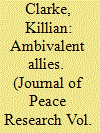

|
|
|
|
|
| Summary/Abstract |
Since the Cold War ended, foreign support has been identified as an important factor in facilitating democratization. However, in certain parts of the world Western enthusiasm for democratization has been highly uneven, particularly when regime change has been achieved through nonviolent revolutionary mobilization. This article introduces the concept of ‘ambivalent allies’ and argues that ambivalence may be highly detrimental to new democracies emerging from nonviolent resistance. Ambivalent allies signal public support for a democratic transition while remaining quietly skeptical about the desirability or viability of the new regime. These misleading signals cause democratic leaders to deprioritize the maintenance of their diverse coalitions, choosing instead an exclusivist approach that alienates their domestic partners. They therefore end up doubly exposed to counterrevolutionary threats, lacking both a broad domestic support base and strong foreign backers. The article illustrates this argument through an examination of Egypt’s 2011 revolution and 2013 coup, drawing on approximately 100 interviews with Egyptian political leaders and foreign diplomats. It shows that the USA’s ambivalence toward the transition contributed to the coup by giving the elected government headed by Mohamed Morsi a false impression that it had strong foreign backing, and that it could afford to marginalize the secularist wing of the original revolutionary coalition. Egypt’s experience is then compared to two cases in which new governments survived counterrevolutionary threats: Burkina Faso in 2014 and Madagascar in 2009. The study contributes to our understanding of how international support may facilitate or undermine democratic consolidation following nonviolent revolutions.
|
|
|
|
|
|
|
|
|
|
|
|
|
|
|
|
| 2 |
ID:
190024


|
|
|
|
|
| Summary/Abstract |
Disputes over self-determination (SD) have led to many civil wars, and a primary alternative, nonviolent campaign, is rarely successful in this context. Yet, while secession is rare, these movements often achieve more limited successes in the form of concessions from the state. This article provides a new assessment of the efficacy of different tactics – violent, nonviolent and conventional political action. It advances an argument that nonviolent tactics can help SD movements to generate indirect pressure on states that contributes to movement success, including greater autonomy. Nonviolence is used to garner attention from international actors using a human rights frame for their cause. International actors that are receptive to these human rights narratives then incentivize concessions for the SD movements and dis-incentivize repression. This happens through a variety of means, such as public shaming of the host state and withholding inter-governmental organization membership. Statistical analysis of violent and nonviolent tactics in SD movements shows that nonviolence can be effective in successfully obtaining concessions. Movements that use nonviolence are twice as likely to see concessions in any given year compared to those that just make demands but do not use nonviolence or violence. The effect of nonviolence is slightly larger than that of violence, which is also associated an increased chance of concession.
|
|
|
|
|
|
|
|
|
|
|
|
|
|
|
|
| 3 |
ID:
190027
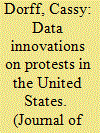

|
|
|
|
|
| Summary/Abstract |
For decades, the United States has been generally excluded from cross-national quantitative datasets on the study of collective action and political resistance. More recently, however, new data collection efforts are on the rise. These projects specifically focus on gathering granular level information about street protests and mobilizations in the United States. In this article, we conduct a rigorous exploratory data analysis of three contemporary protest datasets. These data collect information about the when, where and how of contentious politics in the United States. Our thorough data review first summarizes the key similarities and differences across the datasets. Next, we review the regional, temporal and methodological strengths and weaknesses of each dataset both individually and in contrast to one another. Last, we examine potential research applications of these data by demonstrating what these data reveal about the risks of protesting in these types of events. We conclude by offering recommendations for data use and future data collection strategies for the study of collective action.
|
|
|
|
|
|
|
|
|
|
|
|
|
|
|
|
| 4 |
ID:
190017


|
|
|
|
|
| Summary/Abstract |
Episodes of mass political violence, such as genocide and civil war, have been thought to both encourage and discourage future political mobilization. We square these competing hypotheses by disaggregating between protest onset and resilience. We argue that exposure to mass violence decades ago should on average decrease protest onset, by heightening fears of repression and retribution. However, conditional on protesting, prior exposure to violence should increase protest longevity, by generating greater political grievances that fuel commitment to the cause. We find evidence of both effects in Algeria during the 2019–20 Hirak protests that toppled President Abdelaziz Bouteflika. Pairing an original dataset on massacres during the 1990s civil war with a rolling online survey of 18,000 Algerians in 2019–20, we find that areas exposed to greater violence in the 1990s had on average fewer, but more committed, protesters in 2019–20.
|
|
|
|
|
|
|
|
|
|
|
|
|
|
|
|
| 5 |
ID:
190016
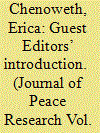

|
|
|
|
|
| Summary/Abstract |
In the past decade, myriad studies have explored the effects of nonviolent resistance (NR) on outcomes including revolutionary success (short-term and long-term) and democratization, and how nonviolent mobilization can play a similar role to violence in affecting social change in some settings. This special issue seeks to advance our understanding of the role of nonviolence by tackling some key assumptions in existing work that are complicated by historical and contemporary realities of deepening polarization worldwide. This issue addresses four key areas within conflict and peace research that limit our ability to make sense of NR: (a) the fragmented nature of civil resistance campaigns in terms of supporters and demands; (b) the increasing prevalence of authoritarian or anti-egalitarian nonviolent campaigns; and (c) the complicated nature of revolutionary success. Cutting across all three of these substantive areas is another key area, which is: (d) the United States as an increasingly salient site of conflict and contention.
|
|
|
|
|
|
|
|
|
|
|
|
|
|
|
|
| 6 |
ID:
190019


|
|
|
|
|
| Summary/Abstract |
When are mass protest movements able to overthrow authoritarian regimes and promote democratic transitions? This article considers whether socially diverse protest movements are more conducive to democratization than movements restricted to one or a few social groups. Coalitions across social groups should impose higher costs on authoritarian regimes through access to a wide range of resources, strategies and sources of leverage. Heterogenous protest coalitions are also more likely to socially overlap with regime supporters and the security forces, which should encourage regime splits and defections. But, diverse protest movements may also be more vulnerable to fragmentation and in-fighting, which may particularly threaten prospects of democracy in the aftermath of an authoritarian regime breakdown. Analyzing new global data mapping the social group composition of anti-regime protest campaigns from 1900 to 2013, the article finds consistent evidence that socially diverse protest movements are more likely to overthrow authoritarian regimes, and this is not driven by protest size. Socially diverse movements are also more likely to end in the short- and long-run establishment of more democratic institutions, suggesting that heterogenous protest movements’ potential for bringing about democracy is more promising than expected. These findings speak to the importance of securing broad and not only large mass movements to promote democracy.
|
|
|
|
|
|
|
|
|
|
|
|
|
|
|
|
| 7 |
ID:
190022
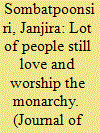

|
|
|
|
|
| Summary/Abstract |
This article examines the interplay between nonviolent movements’ use of polarizing issues for mobilization and pro-regime countermobilization. Thailand has been chosen as an explanatory case study because it has a history of political polarization and pro-regime mass mobilization. I focus on polarizing frames that were incorporated into the 2020 nonviolent resistance campaigns, which addressed a taboo subject in the country: the monarchy. In response, the regime applied various forms of repression, including the mobilization of royalists. But the assumption that the regime single-handedly mobilized countermovements is only half of the story. Autonomous elements within countermovements also joined forces when there were sufficient social conditions. By juxtaposing protest event data with an analysis of mobilizing frames (through movements’ Twitter hashtags), I shed light on a two-pronged process that underpins the nexus between framing choice and countermobilization: (a) how a movement’s choice for polarizing frames sustains existing ideological and identity-based cleavages, antagonizing segments of society that perceive their collective identity to be under siege and; (b) how these ideological and identity-based cleavages also provide social sources for countermobilization. I conclude by addressing some implications of this framing choice–countermobilization nexus on repression dynamics and suggest how we can rethink the relationship between strategic framing and nonviolent resistance campaigns in divided societies.
|
|
|
|
|
|
|
|
|
|
|
|
|
|
|
|
| 8 |
ID:
190018
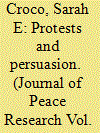

|
|
|
|
|
| Summary/Abstract |
How does the public respond to nonviolent resistance tactics? This survey experiment examines both approval and perceptions of legitimacy for five nonviolent tactics using a sample of American adults. We include two variations in our treatment – first examining responses to different protest tactics, then adding in the factor of co-partisanship, which we argue is a relevant identity in the US political context. In the non-partisan treatments, we find a stark dichotomy between our measures of approval and legitimacy. All nonviolent treatment tactics decrease approval for the neutral activist group using them, but three of four tactic treatments increase the probability that respondents will support our legitimacy indicators (congressional hearing invitation and media attention). We find that partisanship conditions how respondents evaluate nonviolent tactics of resistance, but not in ways we would expect based on the conventional wisdom that liberals favor ‘nonviolent resistance' while conservatives do not. Partisan alignment has a consistent effect on respondent approval of tactics in that the partisan treatment leads to disapproval of out-partisan groups across the nonviolent tactics (compared to no mention of tactic or partisanship). Surprisingly, however, this finding on co-partisanship does not extend to our measures of legitimacy. Partisanship clearly conditions the way that respondents evaluate nonviolent tactics of resistance, but not necessarily in predictable ways.
|
|
|
|
|
|
|
|
|
|
|
|
|
|
|
|
| 9 |
ID:
190020
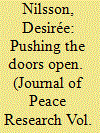

|
|
|
|
|
| Summary/Abstract |
Whereas previous research shows that peace agreements which include a broad segment of society are more likely to lead to sustainable peace, little effort has gone into explaining inclusion itself. We address this gap in the literature by providing the first large-N study to examine the causes of inclusive peace negotiations across civil wars. We argue that civil society actors can gain leverage through mobilization of civilian protest, or build trust through dialogue efforts, thereby enhancing the chances of inclusion of non-warring actors at the negotiation table. The argument is examined by analysing unique and new monthly data on peacemaking efforts in all intrastate armed conflicts in Africa and the Americas, 1989–2018, including measures beyond mere nominal participation, such as whether civil society actors or political parties had substantive roles as either mediators or full participants at the peace talks. Our findings show that protests by civil society actors increase the likelihood that non-warring actors will have a seat at the negotiation table, whereas we find no such effect concerning dialogue efforts. The article contributes by providing new insights into how nonviolent action can shape peace processes by opening the doors to negotiations and is thus part of an emerging research agenda that seeks to bring together the fields of civil resistance and inclusive peace processes.
|
|
|
|
|
|
|
|
|
|
|
|
|
|
|
|
| 10 |
ID:
190025


|
|
|
|
|
| Summary/Abstract |
Human rights abuse tends to increase during national crises, such as civil wars and mass nonviolent uprisings. Under what conditions does this abuse abate or persist? I argue that violent challenges provoke much more coercive state responses, exposing more personnel within the security forces to extreme forms of repression and priming them (both leaders and followers) to reproduce these behaviors after the conflict has terminated. This effect is mitigated or avoided when challengers rely on nonviolent tactics instead of violence, leading to less post-conflict abuse. I test this argument with several quantitative methods, which establish a positive association between nonviolent resistance campaigns and subsequent freedom from political killings. Results also suggest that democratization can partially – but not fully – counteract the repressive legacies of violent conflict. By choosing to specialize in nonviolent tactics, therefore, resistance leaders avoid a repression trap that not even democratization can fully disarm.
|
|
|
|
|
|
|
|
|
|
|
|
|
|
|
|
| 11 |
ID:
190021
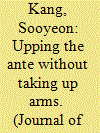

|
|
|
|
|
| Summary/Abstract |
One of the unresolved puzzles in the civil resistance and contentious politics literatures is why some movements that begin seeking limited redress in a certain policy space escalate their claims to demand the ousting of a national leader or the entire regime, a process the article terms ‘demand escalation’. For instance, in the summer of 2019, thousands took to the streets of Hong Kong to protest about a proposed extradition bill that would allow criminal suspects to be sent to mainland China to face trial in courts controlled by the Communist Party. However, even after Hong Kong’s leader, Carrie Lam, announced the formal withdrawal of the controversial bill, protests continued with some calling for greater democracy and others demanding Lam’s resignation. Whereas most of the literature on civil resistance treats demands as fixed and focuses on different methods of struggle to pursue predefined ends, this article shows that demands can change as a result of the state–dissent interaction. The article argues that movements are more likely to escalate their demands when the state responds to the initial nonviolent action with a disproportionate use of force, because such an action intensifies the grievances the protesters have against the state and betrays the remaining trust that people might have had in the government. The analysis of a new quantitative dataset that catalogues both reformist and maximalist opposition campaigns globally supports this claim. By incorporating non-maximalist campaigns into the analysis and not treating demands as fixed, this article adds to our understanding of mass campaigns and highlights an overlooked means by which nonviolent campaigns can up their ante without resorting to violence.
|
|
|
|
|
|
|
|
|
|
|
|
|
|
|
|
| 12 |
ID:
190023


|
|
|
|
|
| Summary/Abstract |
Previously rare events, mass protest movements have become popular vehicles for those seeking political, economic, and social change. How do we evaluate movement success? Most studies addressing movement outcomes are grounded in the goal attainment approach, where movement success is dependent upon fulfilling one’s stated demands. The models derived from this approach heavily rely on visibility and transparency in the policymaking process. These offer limited analytical utility for scholars studying movements in authoritarian states, where policymaking is shrouded and media is state-controlled. Evaluating movements solely on their fulfillment of mission goals is highly problematic, as movements produce more outcomes than their intended goals. Movements also produce unintended benefits: concessions unrelated to the movement’s mission. These include negative consequences, or societal costs. Since movements produce both positive and negative unintended outcomes, any evaluation of a movement should also incorporate the costs associated with new gains. I argue a cost–benefit approach improves scholarly conceptualization and measurement of protest success. I conceptualize protest success as multidimensional and comprised of protest gains and societal costs. I develop a 21-point scale of protest success using Mokken Scale Analysis. AISP diagnostics indicate gains and costs comprise separate subscales, which are collapsed to produce total sum scores. I score 34 nonviolent movements in authoritarian states between 2002 and 2013 on an additive scale. Protests in authoritarian settings attain considerable accomplishments; however, those gains come with significant cost. Most total success scores are negative, indicating considerable backlash is common during and immediately after the demobilization of movements in authoritarian states. Success scores improve upon the canonical binary measure by: (1) offering improved discrimination between movements, (2) identifying cases of regime ‘ignoring’, and (3) pinpointing misclassified cases. By incorporating negative consequences into our evaluations, we advance our understanding why movements deemed successful by scholars are disappointments to their home publics.
|
|
|
|
|
|
|
|
|
|
|
|
|
|
|
|
|
|
|
|
|